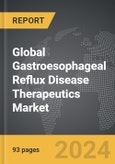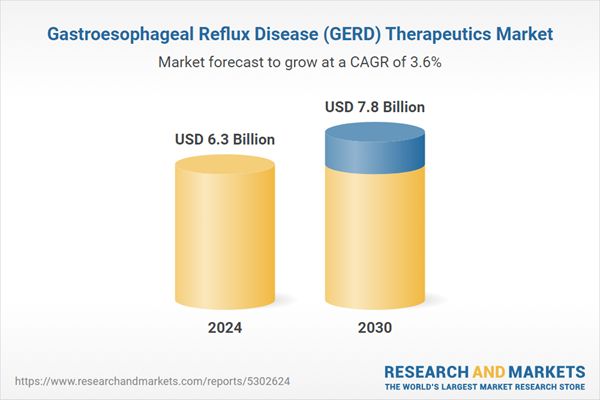Global Gastroesophageal Reflux Disease (GERD) Therapeutics Market - Definition, Key Trends & Drivers Summarized
What Is Gastroesophageal Reflux Disease (GERD) and Why Is It a Significant Health Concern?
Gastroesophageal reflux disease (GERD) is a chronic condition where stomach acid or bile flows back into the esophagus, irritating its lining and leading to symptoms like heartburn, regurgitation, and chest pain. But why is GERD considered a significant health concern? GERD affects millions of people globally and can cause severe discomfort, impact quality of life, and lead to complications like esophagitis, Barrett's esophagus, and an increased risk of esophageal cancer if left untreated. GERD is primarily managed through lifestyle changes, over-the-counter medications, and prescription drugs. As the prevalence of GERD rises due to factors like obesity, sedentary lifestyles, and poor dietary habits, there is a growing demand for effective therapeutic options. The increasing awareness of the long-term risks associated with untreated GERD is driving the need for innovative therapeutics that provide better symptom control and prevent complications.How Are Technological Advancements and Innovations Shaping GERD Therapeutics?
Advancements in medical technology and pharmaceutical research are transforming the treatment of GERD, but how are these innovations improving therapeutic options? One of the key trends is the development of proton pump inhibitors (PPIs), which are among the most commonly prescribed medications for GERD. PPIs work by reducing stomach acid production, offering long-term relief from acid reflux symptoms. Newer formulations of PPIs, such as delayed-release capsules and combination therapies, are improving symptom control and patient adherence by offering more convenient dosing schedules and sustained acid suppression throughout the day.In addition to PPIs, H2 receptor antagonists and antacids are widely used as over-the-counter treatments for mild to moderate GERD symptoms. Recent innovations in H2 blockers include rapid-acting formulations that provide faster relief for patients experiencing acute symptoms. Moreover, new antacid formulations, like liquid gels, offer quicker and more effective neutralization of stomach acid.
Beyond medication, minimally invasive surgical options, such as laparoscopic fundoplication and endoscopic treatments, are gaining traction as alternatives for patients with severe or treatment-resistant GERD. These procedures offer long-term relief by strengthening the lower esophageal sphincter, which helps prevent acid reflux. Furthermore, advancements in diagnostic tools, such as high-resolution esophageal manometry and pH monitoring, are enabling more accurate diagnosis and tailored treatment approaches, improving patient outcomes.
How Are Healthcare Trends and Regulatory Factors Impacting the GERD Therapeutics Market?
What role do healthcare trends and regulatory factors play in shaping the GERD therapeutics market? The rising incidence of lifestyle-related conditions such as obesity and diabetes, which are closely linked to GERD, is driving the demand for effective treatment options. As more people adopt sedentary lifestyles and diets high in processed foods and fats, the prevalence of GERD continues to rise, especially in developed countries. This has led to increased healthcare expenditures on GERD management, including medications, diagnostics, and surgical interventions.In terms of regulations, government agencies such as the U.S. Food and Drug Administration (FDA) and the European Medicines Agency (EMA) closely monitor the approval of GERD medications to ensure their safety and efficacy. Regulatory bodies are particularly focused on the long-term use of PPIs, as prolonged use has been linked to potential side effects, including nutrient deficiencies and an increased risk of infections. This has spurred pharmaceutical companies to develop safer, more effective therapies with fewer adverse effects, including new PPI formulations and non-PPI medications that target GERD symptoms differently, such as potassium-competitive acid blockers (P-CABs).
The focus on patient-centric healthcare is also influencing the market, as there is growing demand for personalized treatment approaches that consider a patient's specific symptoms, medical history, and risk factors. Healthcare providers are increasingly adopting a holistic approach to GERD management, integrating lifestyle modifications, pharmacological treatments, and, in some cases, surgical options to optimize patient outcomes. These healthcare trends, combined with regulatory scrutiny, are shaping the development of safer, more effective GERD therapeutics.
What Are the Key Drivers Behind the Growth of the GERD Therapeutics Market?
The growth in the GERD therapeutics market is driven by several key factors, including the rising prevalence of GERD, advancements in pharmacological treatments, and the increasing demand for effective symptom management. One of the primary drivers is the global rise in GERD cases, fueled by factors like obesity, unhealthy diets, aging populations, and increasing stress levels. These factors contribute to the growing need for medications and treatment strategies that can manage GERD symptoms and prevent complications.Another significant driver is the advancement in drug development, particularly in the creation of more effective and safer proton pump inhibitors (PPIs), H2 receptor antagonists, and novel acid suppression therapies. Pharmaceutical companies are focusing on improving the bioavailability, duration of action, and safety profiles of these drugs to enhance patient compliance and long-term treatment outcomes. Additionally, the rise of combination therapies, where medications are formulated to address multiple aspects of GERD, is gaining popularity as a more comprehensive approach to managing the disease. The increasing awareness of GERD-related complications, such as esophagitis and esophageal cancer, is also contributing to the demand for better diagnostics and personalized treatment options. Patients and healthcare providers are looking for therapeutic solutions that not only alleviate symptoms but also address the root causes of the disease and prevent recurrence. Furthermore, the trend toward minimally invasive surgical treatments for severe or refractory GERD is expanding the scope of treatment options available to patients. These procedures offer long-term relief with fewer side effects compared to long-term medication use, making them an attractive option for patients who do not respond to traditional therapies. Overall, the combination of rising GERD prevalence, advancements in treatment options, and increasing patient awareness is driving the robust growth of the GERD therapeutics market, with significant potential for continued innovation and expansion in the coming years.
Report Scope
The report analyzes the Gastroesophageal Reflux Disease (GERD) Therapeutics market, presented in terms of market value (US$ Thousand). The analysis covers the key segments and geographic regions outlined below.- Segments: Drug Type (Antacids, H2 Receptor Blockers, Proton Pump Inhibitors, Pro-Kinetic Agents).
- Geographic Regions/Countries:World; United States; Canada; Japan; China; Europe (France; Germany; Italy; United Kingdom; Spain; Russia; and Rest of Europe); Asia-Pacific (Australia; India; South Korea; and Rest of Asia-Pacific); Latin America (Argentina; Brazil; Mexico; and Rest of Latin America); Middle East (Iran; Israel; Saudi Arabia; United Arab Emirates; and Rest of Middle East); and Africa.
Key Insights:
- Market Growth: Understand the significant growth trajectory of the Antacids segment, which is expected to reach US$3.6 Billion by 2030 with a CAGR of a 4.4%. The H2 Receptor Blockers segment is also set to grow at 3.2% CAGR over the analysis period.
- Regional Analysis: Gain insights into the U.S. market, valued at $1.7 Billion in 2024, and China, forecasted to grow at an impressive 5.6% CAGR to reach $1.6 Billion by 2030. Discover growth trends in other key regions, including Japan, Canada, Germany, and the Asia-Pacific.
Why You Should Buy This Report:
- Detailed Market Analysis: Access a thorough analysis of the Global Gastroesophageal Reflux Disease (GERD) Therapeutics Market, covering all major geographic regions and market segments.
- Competitive Insights: Get an overview of the competitive landscape, including the market presence of major players across different geographies.
- Future Trends and Drivers: Understand the key trends and drivers shaping the future of the Global Gastroesophageal Reflux Disease (GERD) Therapeutics Market.
- Actionable Insights: Benefit from actionable insights that can help you identify new revenue opportunities and make strategic business decisions.
Key Questions Answered:
- How is the Global Gastroesophageal Reflux Disease (GERD) Therapeutics Market expected to evolve by 2030?
- What are the main drivers and restraints affecting the market?
- Which market segments will grow the most over the forecast period?
- How will market shares for different regions and segments change by 2030?
- Who are the leading players in the market, and what are their prospects?
Report Features:
- Comprehensive Market Data: Independent analysis of annual sales and market forecasts in US$ Million from 2024 to 2030.
- In-Depth Regional Analysis: Detailed insights into key markets, including the U.S., China, Japan, Canada, Europe, Asia-Pacific, Latin America, Middle East, and Africa.
- Company Profiles: Coverage of players such as Abbott, AstraZeneca PLC, Daewoong Pharmaceutical Co., Ltd, Eisai Co., Ltd., GlaxoSmithKline PLC and more.
- Complimentary Updates: Receive free report updates for one year to keep you informed of the latest market developments.
Some of the 42 companies featured in this Gastroesophageal Reflux Disease (GERD) Therapeutics market report include:
- Abbott
- AstraZeneca PLC
- Daewoong Pharmaceutical Co., Ltd
- Eisai Co., Ltd.
- GlaxoSmithKline PLC
- Ironwood Pharmaceuticals, Inc.
- Johnson & Johnson Services, Inc.
- Novartis AG
- Pfizer, Inc.
- RaQualia Pharma, Inc.
- Reckitt Benckiser Group PLC
- SFJ Pharmaceuticals Group
- SRS Pharmaceuticals Pvt., Ltd
- Takeda Pharmaceutical Co., Ltd.
This edition integrates the latest global trade and economic shifts into comprehensive market analysis. Key updates include:
- Tariff and Trade Impact: Insights into global tariff negotiations across 180+ countries, with analysis of supply chain turbulence, sourcing disruptions, and geographic realignment. Special focus on 2025 as a pivotal year for trade tensions, including updated perspectives on the Trump-era tariffs.
- Adjusted Forecasts and Analytics: Revised global and regional market forecasts through 2030, incorporating tariff effects, economic uncertainty, and structural changes in globalization. Includes historical analysis from 2015 to 2023.
- Strategic Market Dynamics: Evaluation of revised market prospects, regional outlooks, and key economic indicators such as population and urbanization trends.
- Innovation & Technology Trends: Latest developments in product and process innovation, emerging technologies, and key industry drivers shaping the competitive landscape.
- Competitive Intelligence: Updated global market share estimates for 2025, competitive positioning of major players (Strong/Active/Niche/Trivial), and refined focus on leading global brands and core players.
- Expert Insight & Commentary: Strategic analysis from economists, trade experts, and domain specialists to contextualize market shifts and identify emerging opportunities.
Table of Contents
Companies Mentioned (Partial List)
A selection of companies mentioned in this report includes, but is not limited to:
- Abbott
- AstraZeneca PLC
- Daewoong Pharmaceutical Co., Ltd
- Eisai Co., Ltd.
- GlaxoSmithKline PLC
- Ironwood Pharmaceuticals, Inc.
- Johnson & Johnson Services, Inc.
- Novartis AG
- Pfizer, Inc.
- RaQualia Pharma, Inc.
- Reckitt Benckiser Group PLC
- SFJ Pharmaceuticals Group
- SRS Pharmaceuticals Pvt., Ltd
- Takeda Pharmaceutical Co., Ltd.
Table Information
| Report Attribute | Details |
|---|---|
| No. of Pages | 186 |
| Published | December 2025 |
| Forecast Period | 2024 - 2030 |
| Estimated Market Value ( USD | $ 6.3 Billion |
| Forecasted Market Value ( USD | $ 7.8 Billion |
| Compound Annual Growth Rate | 3.6% |
| Regions Covered | Global |









